18.15.020 Building Design Standards (Architecture)
A. Purpose and Intent
The intent of this chapter is to establish building design standards that enhance the general appearance, maintain and improve the quality of life for residents and visitors, and protect the value of properties within the City of Olathe. Building design and construction of all buildings, including residential and nonresidential buildings, will have features that are integrally designed, employing quality design principles and building materials that are long-lasting and harmonious to adjoining properties and the community.
All buildings will employ recognized architectural styles and design principles on all sides (four (4) sided architecture) and be proportional, with elements in scale, and designed with a top, middle, and bottom. For example, buildings with three (3) or more stories in height should have masonry or stone (heavy) bases and generally have low-slope roofs with heavy cornices versus pitched, residential style roofs that may be out of scale with the building. Building exterior materials must be applied in an authentic and honest manner reflecting the material’s purpose, weight, and typical use in order to convey a sense of strength and durability.
The architectural design of single-family residences, their materials and color, must be visually harmonious with the overall appearance of the community, natural environment, and other quality development existing in the City. The exterior appearance of single-family residences must consist of complementary building materials and design features that provide a variation in amenities and features and incorporate high-quality standards into the building layout, open space, natural topography, sustainability practices and overall character. The visual elements and amenities will be proportional to the relationships and patterns of the built and natural environment while providing decorative detailing and utilizing high-quality materials.

Examples of quality architectural styles and design principles
B. Applicability
The standards within this chapter will apply to all new buildings, additions, expansions, remodels, and renovations of existing buildings within the jurisdiction of the City of Olathe. Separate architectural standards for buildings in the Downtown District (Section 18.20.210) and the Original Town Overlay District (Section 18.20.280) will apply to developments within those districts in addition to those in this chapter.
For standards pertaining to screening of trash and recycling enclosures, and building- and rooftop-mounted mechanical and utility equipment, see Section 18.30.130.
For standards pertaining to lighting, see Section 18.30.135.
C. Definitions
The terms and phrases used in this section are defined as follows:
Architectural Features
Physical additions to a structure that allow the creation of different styles including, but not limited to, porches, balconies, dormers, bay windows, shutters, belvederes, chimneys, colonnades, towers, cupolas, cornices, eaves, soldier courses, lintels, and decorative ornaments.
Awning
A roof-like cover designed and intended for protection from weather or as a decorative embellishment, and which projects from a wall or roof of a structure over a window, walk, door, or similar feature.
Building Elevation
A flat, scale drawing of the front, rear, or side of a building.
Building Façadism
The application of false or fake building façades or elements over an existing building façade or roof.
Cornice
Overhang of a pitched roof.
Façade Area
The total exterior wall area of all vertical or near-vertical faces of a building wall four (4) feet in width or greater. Façade area will be calculated to include the area of parapets, cornices, and similar wall extensions and trim. Façade area will be calculated to exclude the wall area resulting from minor projections and recessions from the predominant wall plane less than four (4) feet in depth.
Façade or Face
The exterior wall of a building exposed to public view or that wall viewed by persons not within the building.
Major Façade Materials
Exterior finish materials that cover at least five (5) percent of a building’s façade area. Any material that covers less than five (5) percent of a building façade area will not be considered a “major” façade material and will not count towards meeting any requirement for use of multiple Class 1, 2, or 3 materials.
Primary Façade
Means all street-facing façades (i.e., all building façades that face or front along a public or private street, including highways) and façades with a building’s main customer entrance. Buildings may have more than one (1) primary façade, as is the case with buildings located on corner lots and double frontage lots. All other façades will be “secondary” façades.
Street-Facing Façade
Means all building façades that have frontage along or face a public or private street (does not include private drives) at an angle of forty-five (45) degrees or less from the street line. This definition includes those building façades separated from the street by a parking lot or open space.
D. Building Additions
The building design standards provided in this chapter apply to all additions to existing buildings. Additions to a building that was approved subject to these building design standards must meet or exceed the building design standards contained within this chapter. For exceptions for building additions constructed prior to the ordinance codified in this chapter, see Section 18.60.020.F. For buildings constructed under the standards of the ordinance codified in this chapter, exceptions may be granted by the Planning Official to ensure that building additions are aesthetically compatible with the existing building design.
The regulations of this chapter do not apply to building façade maintenance and repair, including repainting of existing painted surfaces, window or siding material replacement with identical or similar materials, and roof replacement with identical or similar materials.
E. General Requirements
Subsections E.1 through E.6, below, apply to all buildings except for agricultural and single-family detached residential building types as stated in subsection G of this section.
1. Building Façadism
Building façadism, defined as the application of false or fake building façades or elements over an existing building façade or roof, is discouraged. Windows or dormers should be in proportion with and match the adjoining roof pitch and have the appearance of being functional and operational. Hip or mansard roofs that only partially conceal a roof well or low slope roof area are also discouraged. Roof parapets and rooftop screen walls must have returns along the sides to conceal the edges.

Examples of building façadism
2. Application of Exterior Building Materials
a. A distinctly different color of fired clay brick (full brick or brick veneer) may be considered as an additional Class 1 or Class 2 material for the purposes of meeting the required minimum number of different major façade materials.
b. Heavy exterior materials, such as any type of brick or stone, must be applied to acknowledge its historic use as a building foundation and structure material. Brick or stone that appears to be unsupported or “float” within a façade will not be permitted, e.g., stone applied to a roof dormer.
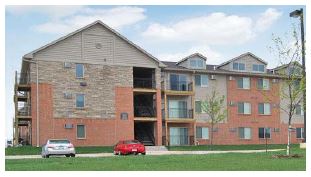
Inappropriate application of stone over brick
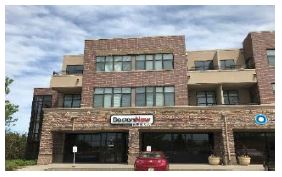
Appropriate application of brick over stone
c. Exterior finishes of brick and stone will not be painted, except as approved by the Planning Official.
d. EIFS is not to be used within ten (10) feet of the finished floor elevation of the façade on which it is located.
e. Thin brick and stone veneer, when utilized, must comply with the following:
(1) Thin brick and stone veneer will only be used in applications where the actual brick or stone thickness will not be distinguishable or is otherwise addressed by adjustments in the wall plane to provide the appearance of full-depth brick or real stone.
(2) L-shaped brick corner pieces and full-depth brick caps must be utilized at all corners and edges to maintain the appearance of full-depth brick.
(3) Thin brick and stone veneer must be continued (returned) a minimum of twelve (12) inches around wall corners to further maintain the appearance of full-depth brick or real stone.

Inappropriate application of thin brick veneer
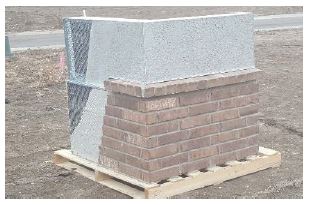
Appropriate application of thin brick veneer
3. Use of Trim on Primary Façades
Except where architecturally unsuitable, appropriately scaled trim of at least three (3) inches in width must be included around all window and door openings, building corners, rooflines, and façade material transitions located on primary façades.
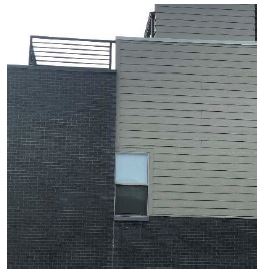
Example of missing window trim
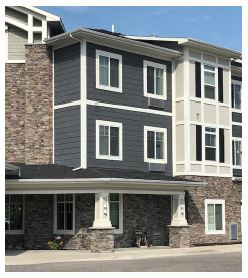
Example of appropriate use of trim
4. Shutters
If used, shutters must be in scale with the adjoining opening and be operational or have the appearance of being operational and functional as a true shade or shutter. Each shutter must be equal to the height and one-half (½) the width of the adjoining opening and must be paired with a matching shutter on the opposite side of the opening, or alternatively, a single shutter must be equal to both the height and width of the adjoining opening.
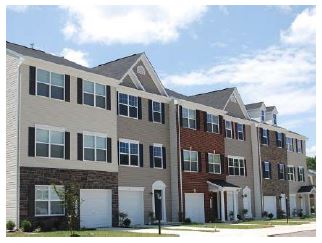
Example of out-of-scale shutters
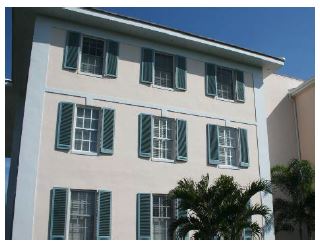
Example of appropriately scaled shutters
5. Soffits, Overhangs, and Cornices
All building soffits, overhangs, and cornices must be appropriately scaled with a typical projection of no less than six (6) inches, except as may be appropriate based on the architectural style.

Examples of appropriately scaled cornices and overhangs
6. Franchise Architecture
Franchise colors and exterior finish materials may be utilized, subject to compliance with the design regulations contained within this chapter.
7. Accessory Building Standards
Accessory buildings in all nonresidential zoning districts must comply with the building design requirements for the principal building of the lot upon which the accessory building is located. Supplemental regulations for garages, carports, and sheds are located in Section 18.50.060. For regulations for residential districts, see Section 18.50.060, and subsections G.2 and G.3 of this section. Temporary and small movable structures, including ATMs and donation boxes, are exempt from these standards.
8. Awnings and Canopies
The following standards will apply to awnings and canopies for all buildings, excluding agricultural, single-family detached residential, and two-family residential building types as stated in subsection G of this section:
a. Attached awnings and canopies that are located on a primary façade or are visible from the street must:
(1) Be in proportion to the wall area or the opening it is covering and be of an appropriate pedestrian scale and height; and
(2) Use nonvinyl materials that are durable in the local climate, such as commercial grade fabric, canvas, tile, slate, architectural quality metal, or similar materials. Asphalt or composition shingle or other materials with a synthetic or plastic appearance are not allowed; and
(3) Use materials with a matte finish; and
(4) Use a single color or two (2) color stripes; and
(5) Be placed within, rather than overlapping, the vertical elements of a building façade that is divided into distinct structural bays; and
(6) Not be internally illuminated.
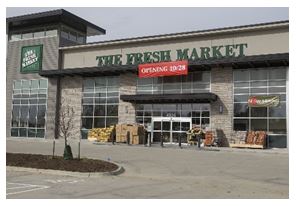
Example of appropriate attached canopies
b. Freestanding canopies, including but not limited to canopies over gas pumps or drive-through services, must be integrated into the roof design of the principal structure or incorporate roof shapes or massing similar to the principal structure.
(1) All exterior canopy surfaces must:
(a) Be made with materials from Classes 1, 2, or 3 (see Table 18.15.020-1) that are compatible with the principal structure; and
(b) Have a matte finish.
(2) Canopy columns must:
(a) Be clad primarily in masonry with materials from Classes 1, 2, or 3 (see Table 18.15.020-1) that are compatible with the principal structure; and
(b) Be a minimum eighteen (18) inches in width.
(3) The use of strips or bands of neon light are prohibited.
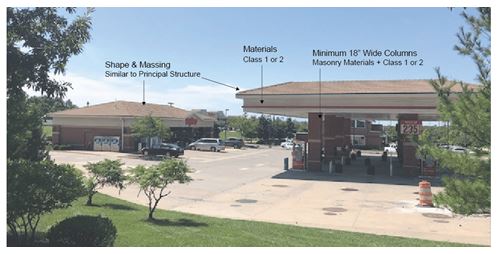
Example of a gas station canopy following design of primary building
9. Gutters and Downspouts
The following standards will apply to all buildings (not including agricultural, single-family detached residential, two-family residential, and horizontally attached residential building types as stated in subsection G of this section):
a. The location and design of exposed gutters and downspouts must be identified on building elevations submitted for approval.
b. Exposed gutters and downspouts must be constructed of high-quality, commercial-grade metal, and must be painted to be compatible with the color of the building.
c. Exposed gutters and downspouts on primary façades are prohibited. Exceptions may be granted by the Planning Official, for downspouts that are designed by the building architect as decorative architectural elements that are an integral component of the building design and coordinated with vertical elements such as towers, columns, or pilasters.
F. Building Exterior Finish Materials
For the purposes of this chapter, exterior building materials are categorized into four (4) different quality classes in Table 18.15.020-1. Class 1 materials are considered “very high-quality” materials, Class 2 materials are considered “high-quality” materials, and Class 3 materials are considered “standard quality” materials. Class 4 materials are considered “limited use” materials for minor trim elements.
The Approving Authority may recategorize any building material listed in Table 18.15.020-1, or may categorize a building material not included within Table 18.15.020-1 for an individual project, if it finds that the material is similar to or of higher quality than the other materials in the same category with regard to:
1. Durability and quality; and
2. Appearance; and
3. Sustainability practices; and
4. Compatibility with the architectural style of the buildings that are subject to the application for approval.
|
|
Class 1 |
Class 2 |
Class 3 |
Class 4 |
Definitions |
|---|---|---|---|---|---|
|
Masonry and Stone (Non-load bearing ) |
|||||
|
Brick veneer, fired clay |
✔ |
Fired clay brick, full-veneer masonry wall system |
|||
|
Brick veneer (thin), fired clay |
✔ |
Thin veneer fired clay brick adhered to a wall surface or wall anchoring system, with the appearance of full brick |
|||
|
Brick paneling, fired clay |
✔ |
Prefabricated panels of thin veneer fired clay brick |
|||
|
Brick veneer, synthetic |
✔ |
Synthetic bricks adhered to wall surface or wall anchoring system |
|||
|
Brick paneling, synthetic |
✔ |
Prefabricated panels of synthetic brick adhered to a wall surface or wall anchoring system |
|||
|
Stone veneer, natural |
✔ |
Genuine stone, full-veneer masonry wall system |
|||
|
Stone paneling, natural |
✔ |
Prefabricated panels of genuine stone adhered to wall surface or wall anchoring system |
|||
|
Stone veneer, synthetic |
✔ |
Synthetic stone adhered to wall surface or wall anchoring system |
|||
|
Stone paneling, synthetic |
✔ |
Prefabricated panels of synthetic stone adhered to a wall surface or wall anchoring system |
|||
|
Stucco, genuine |
✔ |
Traditional Portland cement based stucco applied in 3 coats over a solid surface |
|||
|
Concrete Masonry Units |
|||||
|
Burnished/ground-face block |
✔ |
Concrete modular blocks, smooth finish with large aggregates visible or polished finish and with mortared joints |
|||
|
Patterned or shaped block |
✔ |
Concrete modular blocks, face surface has pattern or shape, not flat, and with mortared joints |
|||
|
Split-faced block |
✔ |
Concrete modular blocks, rough, split-faced finish, and with mortared joints |
|||
|
Plain, flat-faced block |
✔ |
Concrete modular blocks, plain, flat finish, and with mortared joints |
|||
|
Concrete |
|||||
|
Architectural quality precast concrete panels |
✔ |
Highest finish precast concrete panels, textured or burnished, and integrally colored – not painted |
|||
|
Cast-in-place concrete, board formed or decorative form liner |
|
✔ |
Architecturally designed cast-in-place concrete with a high-quality patterned or textured surface created by board forms or decorative concrete form liners |
||
|
Cast-in-place concrete, plain |
✔ |
Textured or smooth finish, may be painted |
|||
|
Site cast and precast concrete panels |
|
✔ |
Site cast and precast concrete panels, plain, smooth finish, may be painted |
||
|
Metal |
|||||
|
Architectural quality, composite metal wall panel systems |
✔ |
High-quality insulated metal panels for decorative surface application, such as Alucobond panel systems |
|||
|
Architectural quality metal wall panel systems, concealed fastening |
✔ |
High-quality metal panels for decorative surface application with concealed fasteners, such as Firestone Delta |
|||
|
Architectural quality metal wall panel systems, exposed fastening |
✔ |
High-quality metal panels for decorative surface application with exposed fasteners, such as Firestone Omega |
|||
|
Metal (panels, siding, and trim) |
✔ |
Standard metal siding and panels, painted or coated for exterior application |
|||
|
Glass |
|||||
|
Clear glass (windows, curtain walls, paneling systems) |
✔ |
Clear glass with no visible tint, reflective coating, coloring, or other covering (not including low-e or UV coatings or treatments) |
|||
|
Glass blocks |
✔ |
Hollow translucent block of varying shapes and sizes made entirely from glass. Also known as glass brick. |
|||
|
Mirrored glass |
✔ |
Glass with a reflective or mirrored coating or finish |
|||
|
Opaque or tinted glass (including color applied) |
✔ |
Glass with a tinted or colored coating or finish or otherwise treated to produce a tint that reduces its opacity. |
|||
|
Spandrel glass |
✔ |
Opaque glass panels with a fire-fused ceramic frit paint; typically used between vision areas of windows to conceal structural columns, floors and shear walls |
|||
|
Other Materials |
|||||
|
Wood (panels and siding) |
|
✔ |
Authentic hardwood or exterior rated, rot-resistant wood paneling and siding |
||
|
Cement fiber board (panels and siding) |
✔ |
Cement panels reinforced with cellulose fibers, such as HardiePlank and HardiePanel |
|||
|
Exterior insulation and finish system (EIFS) |
✔ |
Polystyrene foam covered with a synthetic stucco, water-managed and exterior rated |
|||
|
Composite wood (panels, siding, and trim) |
✔ |
Composite or other synthetic wood types, such as LP SmartSide |
|||
|
Vinyl and PVC (panels, siding, and trim) |
✔ |
Exterior siding and trim that is made from a synthetic resin or plastic. |
|||
|
Ceramic |
|
✔ |
Ceramic tile adhered to a wall surface or wall anchoring system |
||
|
Translucent wall panel systems |
|
✔ |
Panels or blocks, typically hollow, made of translucent polycarbonate material – such as Kalwall |
||
|
Fabric |
|
(not permitted) |
|||
|
Roofing Materials |
|||||
|
Standing seam metal |
✔ |
Vertically run metal panels connected within interlocking raised seams |
|||
|
Metal roof panel system |
✔ |
High-quality metal panels designed for roof application |
|||
|
Metal panel |
✔ |
Standard metal roof panels, designed for roof application |
|||
|
Slate |
✔ |
Natural stone tiles (or shingles) cut from slate, traditionally applied in an overlapping pattern |
|||
|
Tile |
✔ |
Fired clay, ceramic, or concrete roofing tiles applied in an overlaying pattern |
|||
|
Synthetic or composite slate |
✔ |
Molded plastic to mimic the appearance of slate tiles |
|||
|
Green roof |
✔ |
Low-slope roof covered with rooftop plants in a designed rooftop planting system |
|||
|
Simulated metal roofing |
✔ |
Membrane roofing system designed with the appearance of a standing seam metal roof |
|||
|
Membrane or ballast (not visible) |
✔ |
Typical roofing materials for low-slope roofs and not visible from any adjacent public or private street or residential developed or zoned properties |
|||
|
Membrane or ballast (visible) |
|
✔ |
Typical roofing materials for low-slope roofs |
||
|
Asphalt shingles (laminate or dimensional) |
✔ |
Asphalt shingles constructed with a heavy base mat and multiple adhered layers to provide a thicker, dimensional appearance – also known as laminated architectural shingles |
|||
|
Asphalt shingles (3-tab) |
✔ |
Asphalt shingles constructed with a single layer of material and 3 cut shingle “tabs” |
|||
|
Glass roofing |
✔ |
A roof constructed of glass panels or glass tiles within a glass framing system – also known as a roof glazing system |
|||
|
Fabric |
✔ |
Exterior rated fabric designed for application in a canopy or roofing system |
|||
G. Building Design Standards by Building Type
For the purposes of this chapter, all buildings will be categorized by building use type, as listed below. Any building type not listed, or any question as to the appropriate categorization of a building will be as reviewed by the Planning Official. Building design standards are regulated by both building use type and the zoning district in which the building is located.
Building Types
1. Agricultural Building
This includes, but is not limited to, buildings located in the Agricultural District, park picnic shelters, buildings used for agricultural purposes, silos, and greenhouses.
2. Single-Family Detached Residential
This includes, but is not limited to, modular homes, accessory dwellings, bed and breakfasts, and group homes (does not include manufactured homes; see Section 18.50.100).
3. Two-Family Residential
Duplexes.
4. Horizontally Attached Residential
This includes, but is not limited to, townhomes, rowhouses, triplexes, and fourplexes.
5. Vertically Attached Residential
This includes, but is not limited to, apartments, condos, rooming houses, live-work units, community living, homeless shelter, assisted living, skilled care facilities, and continuing care retirement facilities.
6. Nonresidential Building in Residential Zoning District
This includes, but is not limited to, schools, religious institutions, places of assembly, community centers, community food and personal support services, cultural facilities, funeral homes and mortuaries, libraries, public facilities, and governmental buildings.
7. Commercial or Retail Building
This includes, but is not limited to, single- and multi-tenant commercial buildings, day care centers, restaurants, financial institutions, hotels, motels, and recreational and entertainment buildings.
8. Office and Civic Buildings
This includes, but is not limited to, single- and multi-tenant office buildings and, when in nonresidential zoning districts, schools, religious institutions, places of assembly, community centers, community food and personal support services, cultural facilities, funeral homes and mortuaries, libraries, public facilities, and governmental buildings.
9. Mixed-Use Building
A building developed for two (2) or more different uses including, but not limited to, residential, office, manufacturing, retail, or public uses.
10. Industrial Building
(M-1, M-2, or M-3 zoning required.)
Building Type Standards
1. Agricultural Buildings
a. Agricultural buildings are not subject to minimum building façade treatment requirements.
2. Single-Family Detached Residential
a. Single-family detached residential buildings constructed on lots larger than seven thousand two hundred (7,200) square feet are not subject to minimum building façade treatment requirements.
b. Single-family detached residential buildings constructed on lots seven thousand two hundred (7,200) square feet or smaller must comply with the following building design standards:
(1) Building Design Elements
All buildings must incorporate a front-facing entry element to signal the connection between the sidewalk and the house. An entry element must be placed either on the primary façade or be visible from the street. It may extend a maximum of five (5) feet into the minimum front setback area, not including stairs or landings. The following entry elements meet the front-facing entry requirement:
(a) Front Porch
A roofed but unenclosed entry element with a minimum width of eight (8) feet and depth of four (4) feet. Partial walls or railings may be no more than four (4) feet tall.
(b) Side Entry
A roofed but unenclosed entry element with a minimum depth of four (4) feet projecting from a side-facing doorway.
(c) Recessed Entry
An entry recessed at least two (2) feet into the primary façade.
(2) Garage Door Options
Buildings that are less than two (2) stories in height must have garage doors that are subordinate to the primary façade to minimize visual impacts and encourage pedestrian orientation. Select at least one (1) of the following options:
(a) Front-Facing Garage Door with Limited Width
Front-facing garage door(s) extending a maximum of fifty (50) percent of the primary façade width or twenty-eight (28) feet, whichever is greater.
(b) Garage Door Set Back from Primary Façade
Front-facing garage door(s) set back at least five (5) feet from the primary façade.
(c) Side or Rear Facing Garage Doors
Garage door(s) oriented perpendicular to the street or facing the opposite direction from the street.
(3) Primary façades must use a minimum of seventy (70) percent single-family Class A materials and a maximum thirty (30) percent single-family Class B materials as listed in Table 18.15.020-2, below.
|
Single-Family Class A |
Single-Family Class B |
|
Brick, solid |
Brick, panel/veneer |
|
Brick, modular |
Stucco, synthetic (panels) |
|
Stone, modular |
|
|
Stone, veneer |
Concrete masonry unit, split-faced |
|
Stone, synthetic |
Cement fiber board |
|
Stucco, genuine, detailed |
Architectural metal |
|
Concrete, detailed |
Architectural block (glass) |
|
Concrete masonry unit, burnished |
Mirror glass |
|
Clear glass |
Opaque glass |
|
Architectural panels (glass) |
Wood, other synthetics |
|
Synthetic stucco/EIFS (detail only) |
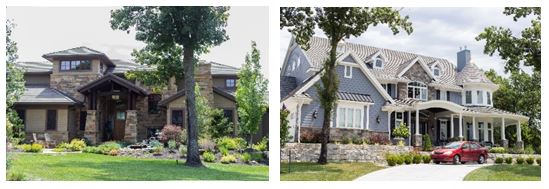
Examples of high-quality design single-family detached residential structures
3. Two-Family Residential
a. Building Façade Treatment
(1) Front Porch or Recessed Entryway
(a) All buildings must have a front porch or recessed front entryway along at least one (1) primary façade for each unit.
(b) The porch or recessed entry must be covered a minimum of four (4) feet in depth, and a minimum of six (6) feet in width.
(2) Garages
(a) The maximum projection of a street-facing garage from the primary façade (front) line will be two (2) feet. Exceptions may be granted by the Planning Official to allow projections greater than two (2) feet.
(b) Any garage with three (3) or more stalls must be recessed a minimum of two (2) feet from the front line adjoining the first and second garage stalls.
b. Exterior Building Materials
(1) Primary façades must use no less than two (2) different Class 1 building finish materials on no less than seventy (70) percent of the surface area.
(2) Secondary façades must use no less than two (2) different Class 1 building finish materials on no less than twenty (20) percent of the surface area.
c. Roofing Materials
Must use Class 1, 2, or 3 roofing materials.
4. Horizontally Attached Residential
a. Building Façade Treatment
(1) Front Porch or Recessed Entryway
(a) Each unit must have its own front porch or recessed front entryway along one (1) primary façade.
(b) The porch or recessed entry must be covered a minimum of four (4) feet in depth, and a minimum of six (6) feet in width.
(2) Garages
(a) All street-facing garages must be recessed a minimum of two (2) feet from the building primary façade (front) line.
(b) Any garage with three (3) or more stalls must be recessed a minimum of two (2) feet from the front line of the adjoining the first and second garage stalls.
(3) Windows
(a) No less than two (2) separate windows must be provided for each dwelling unit along all primary façades. Each window must be no less than six (6) square feet in size.
(b) The primary façade of any accessory building must have no less than two (2) windows or other architectural features for every fifty (50) linear feet of wall façade.
(4) Façade Articulation
Each primary façade must be divided into vertical bays to identify each individual dwelling unit width. Façade bays must be differentiated from the adjoining units through a combination of horizontal and vertical wall articulation, including changes to the design of the individual entryway, changes to the roofline, and through the use of differing exterior finish materials and colors.
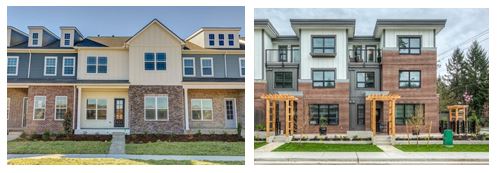
Examples of horizontally attached residential buildings with appropriate façade articulation
One (1) or more of the following façade articulation techniques for each of the following categories must be used on each individual dwelling unit width along all primary façades:
(a) Horizontal Articulation
i Wall OffsetThe offset of the horizontal wall plane by at least four (4) feet extending for the full height of the primary façade.
ii Wall NotchA setback or notch in the horizontal wall plane that is at least four (4) feet deep and eight (8) feet wide for the full height of the primary façade.
iii Wall ProjectionA projection or wall molding that is at least four (4) inches deep and one (1) foot wide for the full height of the primary façade.
(b) Vertical Façade Articulation
i Variation in HeightThe variation in building or parapet height of at least two (2) feet or four (4) feet for buildings greater than two (2) stories in height.
ii Variation in Roof FormThe use of a different roof form, such as changes in roof pitch.
b. Exterior Building Materials
(1) Primary Façades
(a) Must use no less than two (2) different Class 1 building finish materials on no less than seventy (70) percent of the surface area.
(b) Class 4 materials must not be incorporated on more than five (5) percent of any primary façade.
(2) Secondary Façades
(a) Must use no less than two (2) different Class 1 building finish materials on no less than fifty (50) percent of the surface area.
(b) Class 4 materials must not comprise more than five (5) percent of any secondary façade.
c. Roofing Materials
Must use only Class 1 or 2 roofing materials.
5. Vertically Attached Residential
a. Building Façade Treatment
(1) Deck, Patio, or Rooftop Area
Each dwelling unit must have its own deck, balcony, or patio (minimum twenty-four (24) square feet in size), or access to a finished rooftop amenity deck located within the same building. The Approving Authority may approve a well-finished outdoor amenity space as an acceptable alternative. This provision does not apply to senior housing facilities.
(2) Building Entryway
(a) Elevated open walkways and stairways along the exterior of the building are prohibited.
(b) All common building entries must be defined by being covered by a projection from the façade or by being recessed.
(3) Garage Doors (Attached Garages)
(a) Any street-facing garage doors must be recessed a minimum of two (2) feet from the building primary façade (front) line.
(b) Street-facing garage doors must be architecturally treated and include an archway, column, awning, or overhang.
(4) Freestanding Garages, Carports and Parking Structures
(a) The design for any freestanding garages, carports, or parking structures must comply with the façade articulation and exterior building materials requirements for a primary structure and must be compatible with the design of the primary buildings on site.
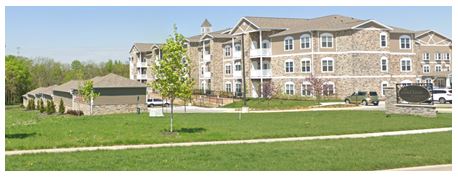
Example of a detached garage compatible with the design of the primary building
(b) All garage and overhead doors and parking bays must face the interior of the site and must not be visible from an arterial roadway.
(c) The primary façade of any accessory structure must have no less than two (2) separate windows for every fifty (50) linear feet of wall façade. Each window must be no less than four (4) square feet in size.
(5) Façade Articulation
Each primary façade must be divided into vertical bays that are no greater than fifty (50) feet in width. Façade bays must be differentiated from the adjoining units through a combination of horizontal and vertical wall articulation including changes to the design of the individual entryway, changes to the roofline, and through the use of differing exterior finish materials and colors.
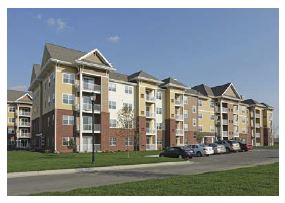
Example of façade bay and articulation
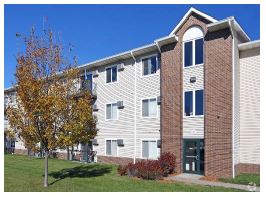
No façade bays or articulation
One (1) or more of the following façade articulation techniques for each of the following categories must be used on every fifty (50) feet of façade width along all primary façades:
(a) Horizontal Articulation
i Wall OffsetThe offset of the horizontal wall plane by at least four (4) feet extending for the full height of the primary façade.
ii Wall NotchA setback or notch in the horizontal wall plane that is at least four (4) feet deep and eight (8) feet wide for the full height of the primary façade.
iii Wall Projection A projection or wall molding that is at least four (4) inches deep and one (1) foot wide for the full height of the primary façade.
(b) Vertical Façade Articulation
i Variation in Height The variation in building or parapet height of at least two (2) feet or four (4) feet for buildings greater than two (2) stories in height.
ii Variation in Roof Form The use of a different roof form, such as changes in roof pitch.
(6) Façade Expression
(a) The primary façades of all buildings two (2) or more stories in height must incorporate one (1) or more of the following façade expression techniques:
1 Expression Line A horizontal projection (or combination of projections) such as a molding or series of balconies extending along at least sixty (60) percent of the primary façade width above the first-floor level.
2 Change in Material A change in the building façade materials between lower and upper floors for the full length of the primary façade.
3 Awning or Canopy The use of an awning or canopy above clear glass windows for at least sixty (60) percent of the primary façade width.
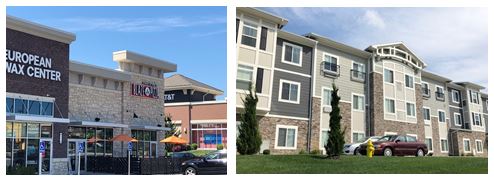
Example of appropriate use of façade expression
b. Exterior Building Materials
(1) Primary Façades
(a) Must use no less than three (3) different Class 1 building finish materials on no less than seventy (70) percent of the surface area of each primary façade with a minimum of twenty (20) percent clear glass.
(b) Class 4 materials must not comprise more than five (5) percent of any primary façade.
(2) Secondary Façades
(a) Must use either two (2) materials from Class 1 or a combination of two (2) materials from Class 1 and Class 2 on no less than fifty (50) percent of the façade with a minimum of ten (10) percent clear glass.
(b) Class 4 materials must not comprise more than five (5) percent of any secondary façade.
c. Roofing Materials
Must use only Class 1 or 2 roofing materials.
6. Nonresidential Buildings in Residential Zoning Districts
Nonresidential buildings (includes, but is not limited to, religious institutions and schools) that are permitted in residential zoning districts are subject to the following standards:
a. Building Façade Treatment
(1) Building Entryway
The main common building entry must be defined with a covered projection from the façade or by a recessed area.
(2) Façade Articulation
Each primary façade must be divided into vertical bays no greater than fifty (50) feet in width. Façade bays must be differentiated from the adjoining units through a combination of horizontal and vertical wall articulation including changes to the design of the individual entryway, changes to the roofline, and through the use of differing exterior finish materials and colors.
One (1) or more of the following façade articulation techniques for each of the categories listed below must be used every fifty (50) feet of façade width along all primary façades:
(a) Horizontal Articulation
i Wall Offset The offset of the horizontal wall plane by at least four (4) feet extending for the full height of the primary façade.
ii Wall Notch A setback or notch in the horizontal wall plane that is at least four (4) feet deep and eight (8) feet wide for the full height of the primary façade.
iii Wall Projection A projection or wall molding that is at least four (4) inches deep and one (1) foot wide for the full height of the primary façade.
(b) Vertical Façade Articulation
i Variation in Height The variation in building or parapet height of at least two (2) feet or four (4) feet for buildings greater than two (2) stories in height.
ii Variation in Roof Form The use of a different roof form, such as changes in roof pitch.

Examples of nonresidential buildings with vertical and horizontal façade articulation
(3) Façade Expression
The primary façades of all buildings two (2) or more stories in height must incorporate one (1) or more of the following façade expression techniques:
(a) Expression Line
A horizontal projection (or combination of projections) such as a molding or series of balconies extending along at least sixty (60) percent of the primary façade width above the first-floor level.
(b) Change in Material
A change in the building façade materials between lower and upper floors for the full length of the primary façade.
(c) Awning or Canopy
The use of an awning or canopy above clear glass windows for at least sixty (60) percent of the primary façade width.
(d) Ornamental Cornice
A cornice projecting a minimum of twelve (12) inches from the primary façade at the top floor parapet level for at least sixty (60) percent of the linear façade width.
b. Exterior Building Materials
(1) Primary Façades
(a) Must use either three (3) materials from Class 1 or a combination of three (3) materials from Class 1 and Class 2 on no less than seventy-five (75) percent of the façade with a minimum of twenty (20) percent clear glass.
(b) Class 4 materials must not comprise more than five (5) percent of any primary façade.
(2) Secondary Façades
(a) Must use either two (2) materials from Class 1 or a combination of two (2) materials from Class 1 and Class 2 on no less than fifty (50) percent of the façade.
(b) Class 4 materials must not comprise more than five (5) percent of any secondary façade.
c. Roofing Materials
Must use only Class 1 or 2 roofing materials.
7. Commercial or Retail Buildings
a. Building Façade Treatment
(1) Building Entryway
Each building entry along all primary façades must be defined with a covered projection from the façade or by a recessed area.
(2) Garages and Overhead Doors
(a) Garages and overhead doors must not face a public street.
(b) If visible from a public street, the garage and overhead doors must be recessed a minimum of four (4) feet from the building façade line and be architecturally treated with a combination of glass windows, archways, columns, canopies, or overhangs.
(3) Façade Articulation
Each primary façade must be divided into vertical bays that are no greater than fifty (50) feet in width. Façade bays must be differentiated from the adjoining units through a combination of horizontal and vertical wall articulation including changes to the design of the individual entryway, changes to the roofline, and through the use of differing exterior finish materials and colors.
One (1) or more of the following façade articulation techniques for each of the following categories must be used on every fifty (50) feet of façade width along all primary façades:
(a) Horizontal Articulation
i Wall OffsetThe offset of the horizontal wall plane by at least four (4) feet extending for the full height of the primary façade.
ii Wall NotchA setback or notch in the horizontal wall plane that is at least four (4) feet deep and eight (8) feet wide for the full height of the primary façade.
iii Wall ProjectionA projection or wall molding that is at least four (4) inches deep and one (1) foot wide for the full height of the primary façade.
(b) Vertical Façade Articulation
i Variation in HeightThe variation in building or parapet height of at least two (2) feet or four (4) feet for buildings greater than two (2) stories in height.
ii Variation in Roof FormThe use of a different roof form, such as changes in roof pitch.

Examples of commercial retail buildings with appropriate vertical and horizontal articulation
(4) Façade Expression
(a) The minimum height for all one (1) story principal buildings must be seventeen (17) feet and the minimum first floor height of all multi-story principal buildings must be eleven (11) feet.
(b) Buildings less than three (3) stories in height must include one (1) tower element or similar special vertical articulation to anchor the main entry or building corner.
(c) The primary façades of all buildings two (2) or more stories in height must incorporate one (1) or more of the following façade expression techniques:
i Expression LineA horizontal projection (or combination of projections) such as a molding or series of balconies extending along at least sixty (60) percent of the primary façade width above the first floor level.
ii Change in MaterialA change in the building façade materials between lower and upper floors for the full length of the primary façade.
iii Awning or CanopyThe use of an awning or canopy above clear glass windows for at least sixty (60) percent of the primary façade width.
iv Ornamental CorniceA cornice projecting a minimum of twelve (12) inches from the primary façade at the top floor parapet level for at least sixty (60) percent of the linear façade width.
b. Exterior Building Materials
(1) Primary Façades
(a) Must use either three (3) materials from Class 1 or a combination of three (3) materials from Class 1 and Class 2 on no less than eighty (80) percent of the façade with a minimum of twenty-five (25) percent clear glass on the first floor and thirty (30) percent clear glass on the upper floors.
(b) Class 4 materials must not comprise more than five (5) percent of any primary façade.
(2) Secondary Façades
(a) Must use either three (3) materials from Class 1 or a combination of three (3) materials from Class 1 and Class 2 on no less than fifty (50) percent of the façade.
(b) Class 4 materials must not comprise more than five (5) percent of any secondary façade.
c. Roofing Materials
Must use only Class 1 or 2 roofing materials.
8. Office Buildings
a. Building Façade Treatment
(1) Building Entryway
Each building entry along all primary façades must be defined with a projection from the façade or a recessed area.
(2) Façade Articulation
Each primary façade must be divided into vertical bays that are no greater than seventy-five (75) feet in width. Façade bays must be differentiated from the adjoining units through a combination of horizontal and vertical wall articulation, including changes to the design of the individual entryway, changes to the roofline, and through the use of differing exterior finish materials and colors.
One (1) or more of the following façade articulation techniques for each of the following categories must be used on every seventy-five (75) feet of façade width along all primary façades:
(a) Horizontal Articulation
i Wall Offset The offset of the horizontal wall plane by at least four (4) feet extending for the full height of the primary façade.
ii Wall Notch A setback or notch in the horizontal wall plane that is at least four (4) feet deep and eight (8) feet wide for the full height of the primary façade.
iii Wall Projection A projection or wall molding that is at least four (4) inches deep and one (1) foot wide for the full height of the primary façade.
(b) Vertical Façade Articulation
i Variation in HeightThe variation in building or parapet height of at least two (2) feet or four (4) feet for buildings greater than two (2) stories in height.
ii Variation in Roof Form The use of a different roof form, such as changes in roof pitch.

Examples of office buildings with appropriate vertical and horizontal articulation
(3) Façade Expression
(a) The minimum height for all one (1) story principal buildings must be seventeen (17) feet and the minimum first floor height of all multi-story principal buildings must be eleven (11) feet.
(b) Buildings less than three (3) stories in height must include one (1) tower element or similar special vertical articulation to anchor the main entry or building corner.
(c) The primary façades of all buildings two (2) or more stories in height must incorporate one (1) or more of the following façade expression techniques:
i Expression LineA horizontal projection (or combination of projections) such as a molding or series of balconies extending along at least sixty (60) percent of the primary façade width above the first floor level.
ii Change in Material A change in the building façade materials between lower and upper floors for the full length of the primary façade.
iii Awning or Canopy The use of an awning or canopy above clear glass windows for at least sixty (60) percent of the primary façade width.
iv Ornamental Cornice A cornice projecting a minimum of twelve (12) inches from the primary façade at the top floor parapet level for at least sixty (60) percent of the linear façade width.
b. Exterior Building Materials
(1) Primary Façades
(a) Must use either two (2) materials from Class 1 or a combination of two (2) materials from Class 1 and Class 2 on no less than seventy (70) percent of the façade with a minimum of twenty-five (25) percent clear glass.
(b) Class 4 materials must not comprise more than five (5) percent of any primary façade.
(2) Secondary Façades
(a) Must use either two (2) materials from Class 1 or a combination of two (2) materials from Class 1 and Class 2 on no less than fifty (50) percent of the façade with a minimum of fifteen (15) percent clear glass.
(b) Class 4 materials must not comprise more than five (5) percent of any secondary façade.
(c) Roofing materials must use only Class 1 or 2 roofing materials.
9. Mixed-Use Buildings
a. Building Façade Treatment
(1) Deck, Patio, or Rooftop Area
Each dwelling unit must have its own deck or patio (minimum twenty-four (24) square feet in size), or access to a finished rooftop amenity deck located within the same building.
(2) Building Entryway
(a) First-floor primary façades must be pedestrian-oriented with a combination of street-facing entries, clear glass storefront windows, awnings, or overhangs.
(b) Individual first floor building entries along all primary façades must be covered by a projection from the façade or be recessed.
(c) Elevated open walkways along the exterior of the building are prohibited.
(d) The main common building entry must be defined by being covered by a projection from the façade or by being recessed.
(3) Garage and Overhead Doors
(a) Garage and overhead doors should not face a public street.
(b) If visible from a public street, the garage and overhead doors must be recessed a minimum of four (4) feet from the building façade line and be architecturally treated with a combination of glass windows, archways, columns, canopies, or overhangs.
(4) Windows
(a) First floor primary façades must incorporate a minimum thirty-five (35) percent clear glass.
(b) Upper floor primary façades must incorporate a minimum twenty-five (25) percent clear glass.
(c) All secondary façades must incorporate a minimum fifteen (15) percent clear glass.
(5) Façade Articulation
Each primary façade must be divided into vertical bays that are no greater than fifty (50) feet in width. Façade bays must be differentiated from the adjoining units through a combination of horizontal and vertical wall articulation, including changes to the design of the individual entryway, changes to the roofline, and through the use of differing exterior finish materials and colors.
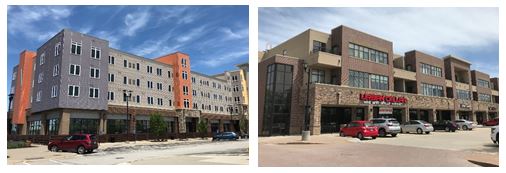
Examples of mixed-use buildings with appropriate vertical and horizontal articulation
One (1) or more of the following façade articulation techniques for each of the following categories must be used on every fifty (50) feet of façade width along all primary façades:
(a) Horizontal Articulation
i Wall OffsetThe offset of the horizontal wall plane by at least four (4) feet extending for the full height of the primary façade.
ii Wall NotchA setback or notch in the horizontal wall plane that is at least four (4) feet deep and eight (8) feet wide for the full height of the primary façade.
iii Wall ProjectionA projection or wall molding that is at least four (4) inches deep and one (1) foot wide for the full height of the primary façade.
(b) Vertical Façade Articulation
i Variation in HeightThe variation in building or parapet height of at least two (2) feet or four (4) feet for buildings greater than two (2) stories in height.
ii Variation in Roof FormThe use of a different roof form, such as changes in roof pitch.
(6) Façade Expression
(a) The minimum height for all one (1) story principal buildings must be seventeen (17) feet and the minimum first floor height of all multi-story principal buildings must be eleven (11) feet.
(b) Buildings less than three (3) stories in height must include one (1) tower element or similar special vertical articulation to anchor the main entry or building corner.
(c) The primary façades of all buildings two (2) or more stories in height must incorporate one (1) or more of the following façade expression techniques:
i Expression LineA horizontal projection (or combination of projections) such as a molding or series of balconies extending along at least sixty (60) percent of the primary façade width above the first floor level.
ii Change in MaterialA change in the building façade materials between lower and upper floors for the full length of the primary façade.
iii Awning or CanopyThe use of an awning or canopy above clear glass windows for at least sixty (60) percent of the primary façade width.
iv Ornamental CorniceA cornice projecting a minimum of twelve (12) inches from the primary façade at the top floor parapet level for at least sixty (60) percent of the linear façade width.
b. Exterior Building Materials
(1) Primary Façades
(a) Must use no less than three (3) different Class 1 building finish materials on no less than eighty (80) percent of the surface area of each primary façade with a minimum of thirty-five (35) percent clear glass on the first floor and twenty (20) percent clear glass on the upper floors.
(b) Class 4 materials must not comprise more than five (5) percent of any primary façade.
(2) Secondary Façades
(a) Must use either three (3) materials from Class 1 or a combination of three (3) materials from Class 1 and Class 2 on no less than sixty (60) percent of the façade with a minimum of fifteen (15) percent clear glass.
(b) Class 4 materials must not comprise more than five (5) percent of any secondary façade.
c. Roofing Materials
Must use only Class 1 or 2 roofing materials.
10. Industrial Buildings
a. Building Façade Treatment
(1) Building Entryway
The main common building entry must be defined with a projection from the façade or a recessed area.
(2) Garage and Overhead Doors
Garage and overhead doors may only face a local or collector public street, unless completely screened from view. If visible, street-facing doors must include a three (3) foot deep canopy or overhang above the doorway, be recessed a minimum of two (2) feet from the building façade line, and the door be architecturally treated.
(3) Windows
First floor primary façade areas must incorporate a minimum fifteen (15) percent clear glass.
(4) Façade Articulation
Each primary façade must be divided into vertical bays that are no greater than fifty (50) feet in width for buildings less than one hundred thousand (100,000) square feet in size and one hundred (100) feet in width for buildings one hundred thousand (100,000) square feet and greater in size. Façade bays must be differentiated from the adjoining units through a combination of horizontal and vertical wall articulation, including changes to the design of the individual entryway, changes to the roofline, and through the use of differing exterior finish materials and colors.
Buildings less than three (3) stories in height must include tower elements or similar special vertical articulation to bookend the building or to anchor the main entry or building corner.
One (1) or more of the following façade articulation techniques for each of the following categories must be used on every vertical bay width (as required above) along all primary façades:
(a) Horizontal Articulation
i Wall OffsetThe offset of the horizontal wall plane by at least four (4) feet extending for the full height of the primary façade.
ii Wall NotchA setback or notch in the horizontal wall plane that is at least four (4) feet deep and eight (8) feet wide for the full height of the primary façade.
iii Wall ProjectionA projection or wall molding that is at least four (4) inches deep and one (1) foot wide for the full height of the primary façade.
(b) Vertical Articulation
i Variation in HeightThe variation in building or parapet height of at least four (4) feet.
ii Variation in Roof FormThe use of a different roof form, such as changes in roof pitch.
b. Exterior Building Materials
(1) Primary Façades
(a) Must use either two (2) materials from Class 1 or a combination of two (2) materials from Class 1 and Class 2 on no less than seventy-five (75) percent of the façade with a minimum of fifteen (15) percent clear glass on the first floor.
(b) Class 4 materials must not comprise more than twenty-five (25) percent of any primary façade.
(2) Secondary Façades
(a) Must use either two (2) materials from Class 1 or a combination of two (2) materials from Class 1, Class 2, or Class 3 on no less than forty (40) percent of the façade.
(b) Class 4 materials must not comprise more than fifty (50) percent of any secondary façade.
(c) Roofing Materials
1Must use only Class 1, 2, or 3 roofing materials.
2Accessory structures not visible from a public street or adjoining residentially zoned or developed property may utilize Class 4 roofing materials. (Ord. 19-63 §§ 4, 11, 2019; Ord. 18-48 § 2, 2018; Ord. 16-20 §4, 2016; Ord. 15-16 §3, 2015)